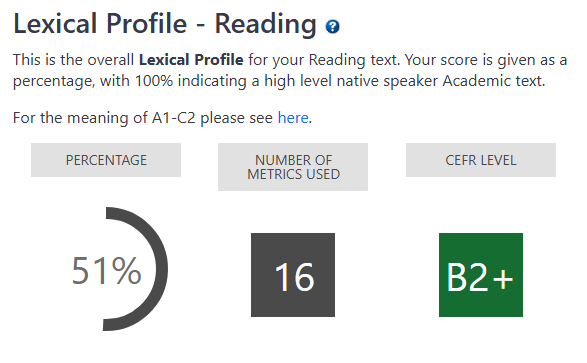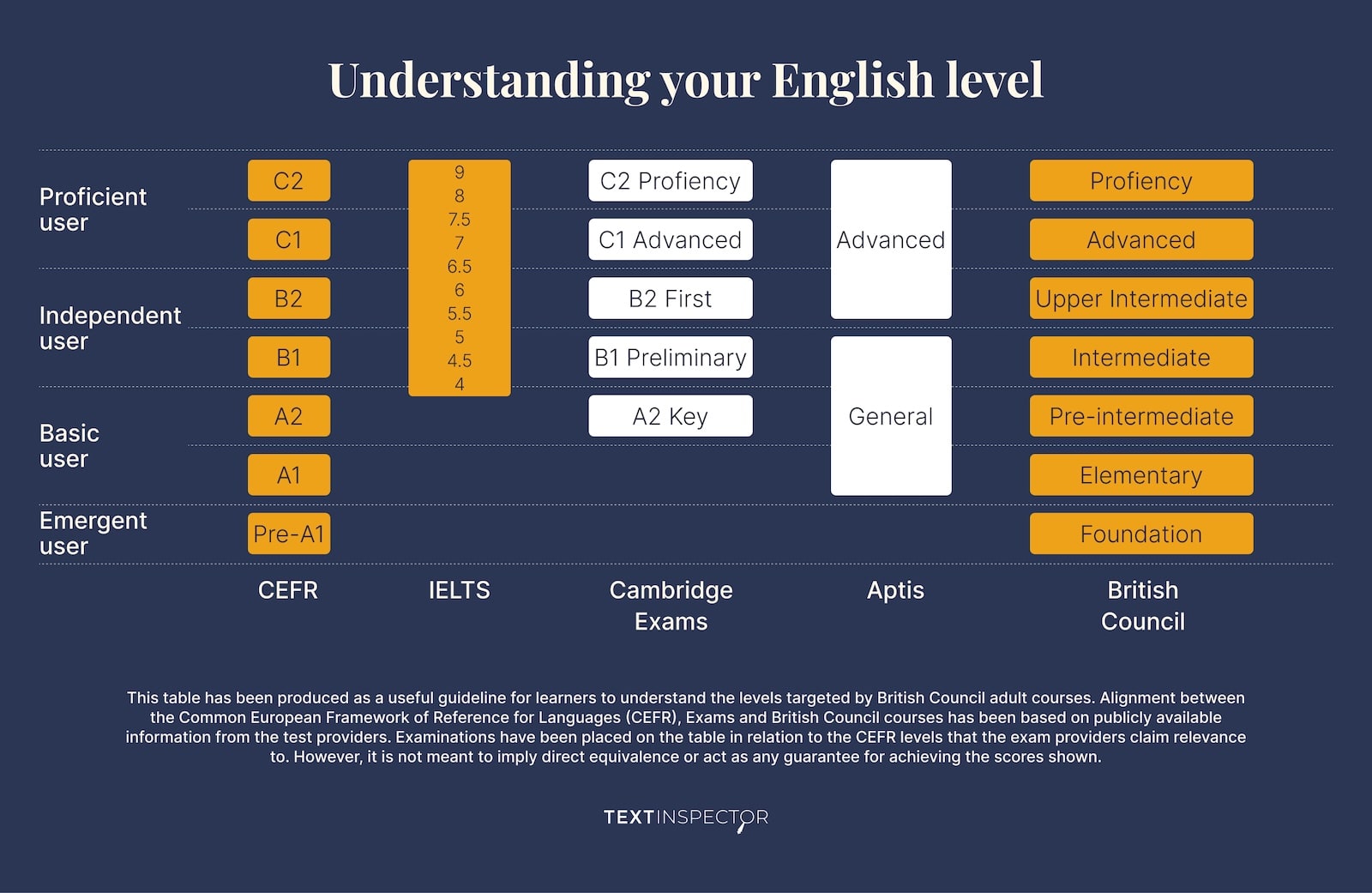
In our previous article, we explored the CEFR levels of the first three Harry Potter books, which fall between B1 and B2. In this follow-up, we turn our attention to the remaining four books in the series.
Using Text Inspector to analyse vocabulary, grammar, and overall language complexity, we examined Goblet of Fire, Order of the Phoenix, Half-Blood Prince, and Deathly Hallows. Our findings suggest a noticeable increase in linguistic difficulty, placing these books in the B2–C1 range.
This makes them more suitable for upper-intermediate to advanced learners looking for more mature themes and complex narratives. Our insights can help teachers design activities that match their students’ level more precisely.
CEFR Level Analysis of the Harry Potter Series
Harry Potter and the Goblet of Fire
Compared to the first three books, Goblet of Fire shows a significant increase in linguistic complexity. Sentences become more complex, vocabulary expands, and figurative language and sophisticated grammar are used more frequently. Let’s look at an example.
Goblet of Fire extract
“Harry’s nerves mounted as June the twenty-fourth drew closer, but they were not as bad as those he had felt before the first and second tasks. For one thing, he was confident that, this time, he had done everything in his power to prepare for the task. For another, this was the final hurdle, and however well or badly he did, the tournament would at last be over, which would be an enormous relief.
Breakfast was a very noisy affair at the Gryffindor table on the morning of the third task. The post owls appeared, bringing Harry a good luck card from Sirius. It was only a piece of parchment, folded over and bearing a muddy paw print on its front, but Harry appreciated it all the same. A screech owl arrived for Hermione, carrying her morning copy of the Daily Prophet as usual. She unfolded the paper, glanced at the front page, and spat out a mouthful of pumpkin juice all over it.” [Chapter 31 – The Third Task].
Goblet of Fire analysis

Why is this B2+?
There are some metrics Text Inspector has used to determine the CEFR level of the Goblet of Fire extract we’ve just analysed.
Readability
The Flesch-Kincaid readability formulas are popular tools used to measure how easy a text is to read and understand. The Flesch Reading Ease score ranges from 0 to 100, with higher scores meaning simpler, more accessible writing.
The Flesch-Kincaid Grade Level converts this into a U.S. school grade, showing how many years of education someone needs to understand the text.
The Gunning Fog Index offers a similar estimate but focuses more on sentence length and complex words. Read here on how Text Inspector uses these metrics. In this case, the results were as follows:
Lexical Diversity
This refers to how many different meaningful words—like nouns, verbs, adjectives, and adverbs—appear in a text. The more varied the vocabulary, the more lexically diverse the text is.
A text with high lexical diversity avoids repeating words and instead uses a wider range of vocabulary, making it richer and more complex. Text Inspector measures this by using two methods: MTLD and vocd-D.
These methods are considered reliable because they give a more balanced picture of how diverse the vocabulary is, although the results can change depending on the length of the text. That’s why you should run the analysis more than once. In the case of Goblet of Fire, Text Inspector yielded this result:
Lexical Sophistication
Text Inspector works with Cambridge University Press to offer a tool that analyses vocabulary in texts using the English Vocabulary Profile (EVP), which links words, phrases, idioms, and collocations to CEFR levels (A1–C2).
Based on data from the Cambridge Learner Corpus, the EVP helps identify what language learners typically know at each stage. This makes it a valuable resource for teachers looking to create level-appropriate materials and improve language learning. The analysis of the extract generated these results:
Harry Potter and the Order of the Phoenix
Order of the Phoenix is more complex than the first three books due to its denser language, longer and more layered sentence structures, and more abstract vocabulary. The book also deals with heavier themes such as grief, trauma, and political corruption. These features mark a clear step up in both linguistic and thematic complexity, placing the book at a higher CEFR level.
Order of the Phoenix extract
“Kreacher, it transpired, had been lurking in the attic. Sirius said he had found him up there, covered in dust, no doubt looking for more relics of the Black family to hide in his cupboard. Though Sirius seemed satisfied with this story, it made Harry uneasy. Kreacher seemed to be in a better mood on his reappearance, his bitter muttering had subsided somewhat and he submitted to orders more docilely than usual, though once or twice Harry caught the house-elf staring at him avidly, but always looking quickly away whenever he saw that Harry had noticed.
Harry did not mention his vague suspicions to Sirius, whose cheerfulness was evaporating fast now that Christmas was over. As the date of their departure back to Hogwarts drew nearer, he became more and more prone to what Mrs. Weasley called “fits of the sullens,” in which he would become taciturn and grumpy, often withdrawing to Buckbeak’s room for hours at a time. His gloom seeped through the house, oozing under doorways like some noxious gas, so that all of them became infected by it.” [Chapter 24 – Occlumency].
Order of the Phoenix analysis
Why is this C1?
Average Syllables per Word/Average Words per Sentence
These metrics are key indicators of text complexity. More syllables suggest more advanced vocabulary, while longer sentences point to more complex grammar. Together, they help assess how challenging a text might be for readers. In the case of Order of the Phoenix, the results were:
The British National Corpus (BNC)
Text Inspector uses the British National Corpus (BNC) to show how English is really used by native speakers across a range of real-life contexts. With over 100 million words from sources like newspapers, fiction, and everyday conversation, the BNC offers a rich, descriptive view of authentic language use—helping learners, teachers, and researchers go beyond textbook rules to understand vocabulary, grammar, and collocations as they naturally occur. The analysis yielded these results:
Harry Potter and the Half-Blood Prince
Harry Potter and the Half-Blood Prince is more complex than the earlier books because it uses more advanced storytelling techniques, like shifting perspectives and flashbacks through the Pensieve. The language also gets more sophisticated, with more complex sentences and vocabulary. The themes are darker and deal with heavier topics like death, betrayal, and tough moral choices. All of this makes the book more challenging to read.
Half-Blood Prince extract
“Though he already knew it by heart, Harry had been stealing glances at this missive every few minutes since seven o’clock that evening, when he had first taken up his position beside his bedroom window, which had a reasonable view of both ends of Privet Drive. He knew it was pointless to keep rereading Dumbledore’s words; Harry had sent back his “yes” with the delivering owl, as requested, and all he could do now was wait: Either Dumbledore was going to come, or he was not.
But Harry had not packed. It just seemed too good to be true that he was going to be rescued from the Dursleys after a mere fortnight of their company. He could not shrug off the feeling that something was going to go wrong—his reply to Dumbledore’s letter might have gone astray; Dumbledore could be prevented from collecting him; the letter might turn out not to be from Dumbledore at all, but a trick or joke or trap. Harry had not been able to face packing and then being let down and having to unpack again. The only gesture he had made to the possibility of a journey was to shut his snowy owl, Hedwig, safely in her cage.” [Chapter 3 – Will and Won’t].
Half-Blood Prince analysis
Why is this C1+?
The Corpus of Contemporary American English
Text Inspector uses the Corpus of Contemporary American English (COCA) to help accurately determine the CEFR level of a text by analysing how words are used in real-life contexts. Because COCA is based on over a billion words from everyday sources like TV shows, magazines, and academic writing, it gives a clear picture of how common or advanced each word is. This allows teachers and learners to see whether a text matches a specific CEFR level based on authentic language use. The results were as follows:
Metadiscourse Markers
Text Inspector uses metadiscourse markers to measure how difficult a text is to read, which helps determine its CEFR level. These markers—like “however,” “therefore,” or “in conclusion”—show how well a writer organises ideas, connects arguments, and guides the reader through the text. The more complex and varied these markers are, the more cognitively demanding the text becomes, indicating a higher reading level. In the case of this extract, the results were:
Harry Potter and the Deathly Hallows
Harry Potter and the Deathly Hallows is more complex than the other books in the series because it features denser vocabulary, more abstract themes, and a higher frequency of advanced grammatical structures. The plot is darker and more politically charged, with less repetition and fewer contextual clues, making it more challenging to read and understand—especially for English learners or younger readers.
Deathly Hallows extract
“He now proceeded a little more cautiously. Kneeling down beside the trunk again, he groped around in the bottom and, after retrieving an old badge that flickered feebly between SUPPORT CEDRIC DIGGORY and POTTER STINKS, a cracked and worn-out Sneakoscope, and a gold locket inside which a note signed R. A. B. had been hidden, he finally discovered the sharp edge that had done the damage. He recognized it at once. It was a two-inch-long fragment of the enchanted mirror that his dead godfather, Sirius, had given him. Harry laid it aside and felt cautiously around the trunk for the rest, but nothing more remained of his godfather’s last gift except powdered glass, which clung to the deepest layer of debris like glittering grit.
Harry sat up and examined the jagged piece on which he had cut himself, seeing nothing but his own bright green eye reflected back at him. Then he placed the fragment on top of that morning’s Daily Prophet, which lay unread on the bed, and attempted to stem the sudden upsurge of bitter memories, the stabs of regret and of longing the discovery of the broken mirror had occasioned, by attacking the rest of the rubbish in the trunk.”
[Chapter 2 – In Memoriam].
Deathly Hallows analysis
Why is this C2+?
1. The Academic Word List
Text Inspector uses the Academic Word List (AWL)—a collection of 570 word families commonly found in academic texts—to assess how difficult and formal a text is. Because these words (like assume, modify, or precede) aren’t typical in everyday conversation, their presence suggests a higher level of reading complexity. The more AWL vocabulary a text contains, the more likely it is to correspond to a higher CEFR level. The results were:
2. Readability and Lexical Sophistication
As discussed before, these are other metrics that can be used to determine the CEFR level of a text. In the case of Deathly Hallows, the analysis yielded these results:
These analyses carried out on Text Inspector are easy to understand and an invaluable tool for teachers when deciding how to use authentic material in the classroom, by finding the right CEFR level to cater to their students’ needs.
Using the Later Harry Potter Books in Advanced English Classrooms

The later Harry Potter books (from Order of the Phoenix onwards) are excellent for advanced English classrooms, starting at a B2+ level. Their sophisticated language, complex narratives, and rich themes allow teachers to explore advanced vocabulary, grammar, and encourage discussions on mature topics.
Some potential classroom activities include:
- Close reading tasks to analyse language, tone, and style
- Vocabulary building exercises using words in context
- Debates or roleplays on key moral and political decisions made by characters
- Creative writing tasks, such as alternate endings or missing scenes
- Discussion circles focused on literary analysis and thematic exploration
These exercises not only boost linguistic competence but also critical thinking and cultural literacy.
Conclusions
As the Harry Potter series progresses, so does the linguistic and conceptual complexity of the texts. The later books feature longer sentences, more abstract vocabulary, and greater use of metadiscourse, which guides readers through subtle arguments and perspectives. These elements raise the CEFR level of the texts, making them more suitable for advanced learners who can handle both linguistic challenges and mature themes like identity, power, and loss.
For English educators, this progression offers a valuable learning opportunity. With the help of tools like Text Inspector, teachers can dig deeper into the language of authentic materials like Harry Potter and adapt them effectively for the ESL classroom. Whether you’re selecting excerpts for reading practice, designing vocabulary lessons, or fostering discussion, Text Inspector can help you make informed, level-appropriate choices. Dive into the magic of real-world texts and make them work for your learners!
Share
Related Posts

What Is The CEFR Level of Harry Potter? (Part 1)
12 May, 2025
The Harry Potter series is not only a global literary success but also a valuable […]
Read More ->
CEFR Levels Explained: Your Comprehensive FAQ Guide
27 June, 2025
The Common European Framework of Reference for Languages (CEFR) is essential for language learning, providing […]
Read More ->
What is the Expected CEFR Level for the TOEFL Exam?
19 July, 2025
Helping students prepare for high-stakes exams like the TOEFL can be both exciting and overwhelming. […]
Read More ->